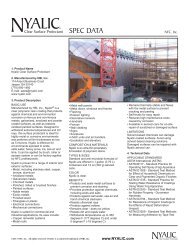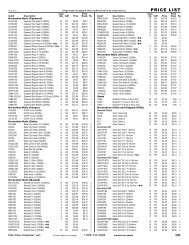Blacksmith Metalsmith Knifemaker Farrier Blacksmith ... - Pieh Tool
Blacksmith Metalsmith Knifemaker Farrier Blacksmith ... - Pieh Tool
Blacksmith Metalsmith Knifemaker Farrier Blacksmith ... - Pieh Tool
You also want an ePaper? Increase the reach of your titles
YUMPU automatically turns print PDFs into web optimized ePapers that Google loves.
BK78<br />
Heat Treatment, Selection, and<br />
Application of <strong>Tool</strong> Steels, Bryson<br />
210 pages, 9 x 6 (Softcover)<br />
An ideal reference for blacksmiths, tool makers, heat<br />
treaters, and engineers. Provides practical information<br />
about machinability, shock resistance, and wear, and<br />
it offers step-by-step “recipes” for properly heating a<br />
wide range of tool steels. Explains how to lengthen<br />
tool life, eliminate dangerous practices, avoid metal failure,<br />
and eliminate costly mistakes. In addition, it includes properties,<br />
attributes, and qualities of popular tool steels.<br />
BK611<br />
How I Pour Babbitt Bearings, Gingery<br />
43 pages, 5-1/2 x 8-7/16 (Softcover)<br />
Prior to 1940 just about every machine built used<br />
Babbitt bearings, and every mechanic was familiar<br />
with them. Today things are quite different. Many<br />
people get a great deal of satisfaction from restoring<br />
old tools, machinery and automobiles that are destined<br />
for the scrap yard. A lot of old, heavily built machinery<br />
is still available at scrap prices. Often all that is required to put one<br />
of these machines back in working order is cleaning and painting<br />
individual parts and re-pouring the Babbitt bearings. This booklet<br />
contains the basic information you need to melt and pour, in other<br />
words, restore Babbitt bearings. You look over Vince’s shoulder as<br />
he restores a sawmill arbor to like-new condition. Babbitt is excellent<br />
bearing material, and with it you can quickly and easily make low-cost<br />
custom bearings for those off-the-wall machine tools you plan to build.<br />
BK278<br />
How to Cast Small Metal and Rubber Parts,<br />
Cannon<br />
176 pages, 5-1/4 x 8-1/4 (Softcover)<br />
Learn to cast any parts made of rubber or metal<br />
hood ornaments, kitchen utensils, automotive parts,<br />
etc. Choose the right metal for the job, learn to design<br />
and make molds, cast in sand, and how to repair<br />
castings. Includes instructions on core making, repairing<br />
defects in castings, finishing, grinding, polishing, buffing and more.<br />
BK290<br />
Lost-Wax Casting, Feinberg<br />
74 pages, 7 x 10 (Softcover)<br />
Outlines the basic techniques of lost-wax casting<br />
and describes the equipment needed to carry<br />
out the process successfully. Explains how the<br />
equipment can be made, using local labor and<br />
natural resources readily available in developing<br />
countries.<br />
Johnson Heating Furnaces<br />
The NEW Johnson Ceramic Shell Burn-Out<br />
Furnace The new Johnson Ceramic Shell Burn-Out<br />
Furnaces are fast, clean, safe, easy to operate and<br />
affordable. They are designed for use by artists and<br />
industry alike for both training and high production<br />
work at a cost dramatically lower than conventional<br />
alternatives. Johnson is the first ceramic shell<br />
burn-out system easily within the grasp of every<br />
Department of Art and fine arts foundry.<br />
BOOKS FOUNDRY/METALLURGY<br />
BK328<br />
Melting Iron in the Cupola, Hurst<br />
220 pages, 5-1/2 x 8-1/2 (Softcover)<br />
A great reference for the small foundry. Extremely detailed<br />
information, formulas, and diagrams regarding all aspects of<br />
melting iron. It has 11 chapters covering all phases of construction,<br />
types, maintenance, charging, firing and melting of iron in the<br />
cupola furnace.<br />
BK259<br />
Metalcasting, Ammen<br />
375 pages, 7-3/8 x 9-1/4 (Softcover)<br />
This detailed and “interesting” book describes,<br />
in simple terms, every type of metal casting<br />
technique imaginable. There are plenty of clear<br />
diagrams explaining everything from how a<br />
cupola furnace works to pouring clean ingots.<br />
Packed with step-by-step guidelines for getting<br />
started and working effectively and efficiently in this time-honored<br />
craft. You get hands-on advice and cost-cutting tips, plus sound<br />
ideas for safety and productivity. This guide shows you how to<br />
use metal crafting tools and processes, casting and mold making,<br />
molding sands, molding equipment, metal melting, handling, and<br />
pouring devices, alloys and more. Patination of cast metals, working<br />
with chemically bonded molds, the newest molding, casting, and<br />
pattern-making techniques are just a few of what is taught.<br />
BK5<br />
Steel <strong>Tool</strong>making Strategies and<br />
Techniques Before 1870, Brack<br />
156 pages, 10 x 8 (Softcover)<br />
This book explores ancient and early modern<br />
steel and toolmaking strategies and techniques,<br />
including those of early Iron Age, Roman,<br />
medieval, and Renaissance metallurgists and<br />
toolmakers. Also reviewed are the technological<br />
innovations of the Industrial Revolution, the contributions of the<br />
English industrial revolutionaries to the evolution of the factory<br />
system of mass production with interchangeable parts, and the<br />
development of bulk steelmaking processes and alloy steel<br />
technologies in the latter half of the 19th century. It includes<br />
an extensive bibliography of resources pertaining to steel-and<br />
toolmaking techniques from the early Bronze Age to the beginning of<br />
bulk-processed steel production after 1870. Illustrated.<br />
For more information,<br />
see pages 88 and 89.<br />
<strong>Pieh</strong> <strong>Tool</strong> Company, Inc. 1-888-743-4866 109




